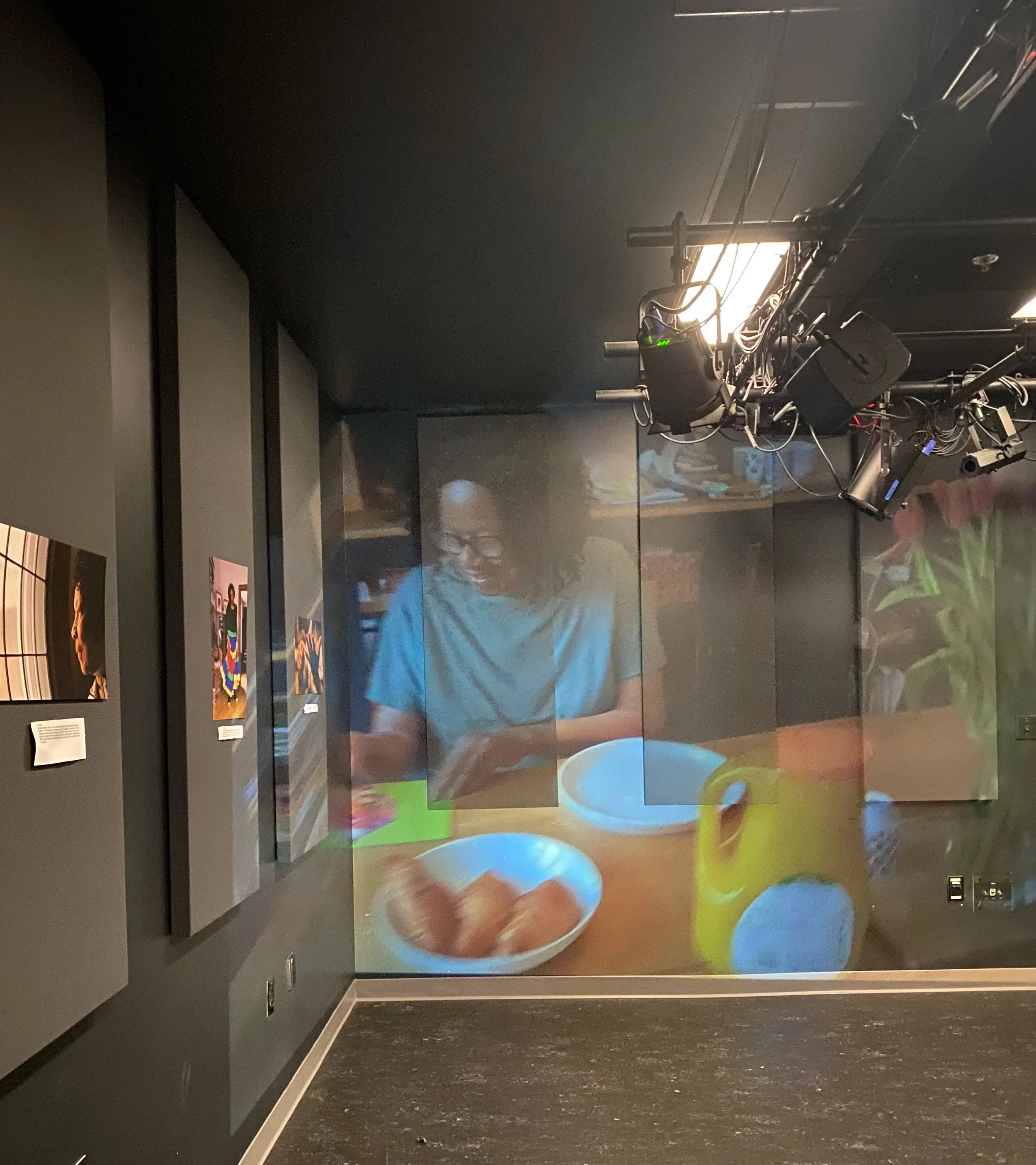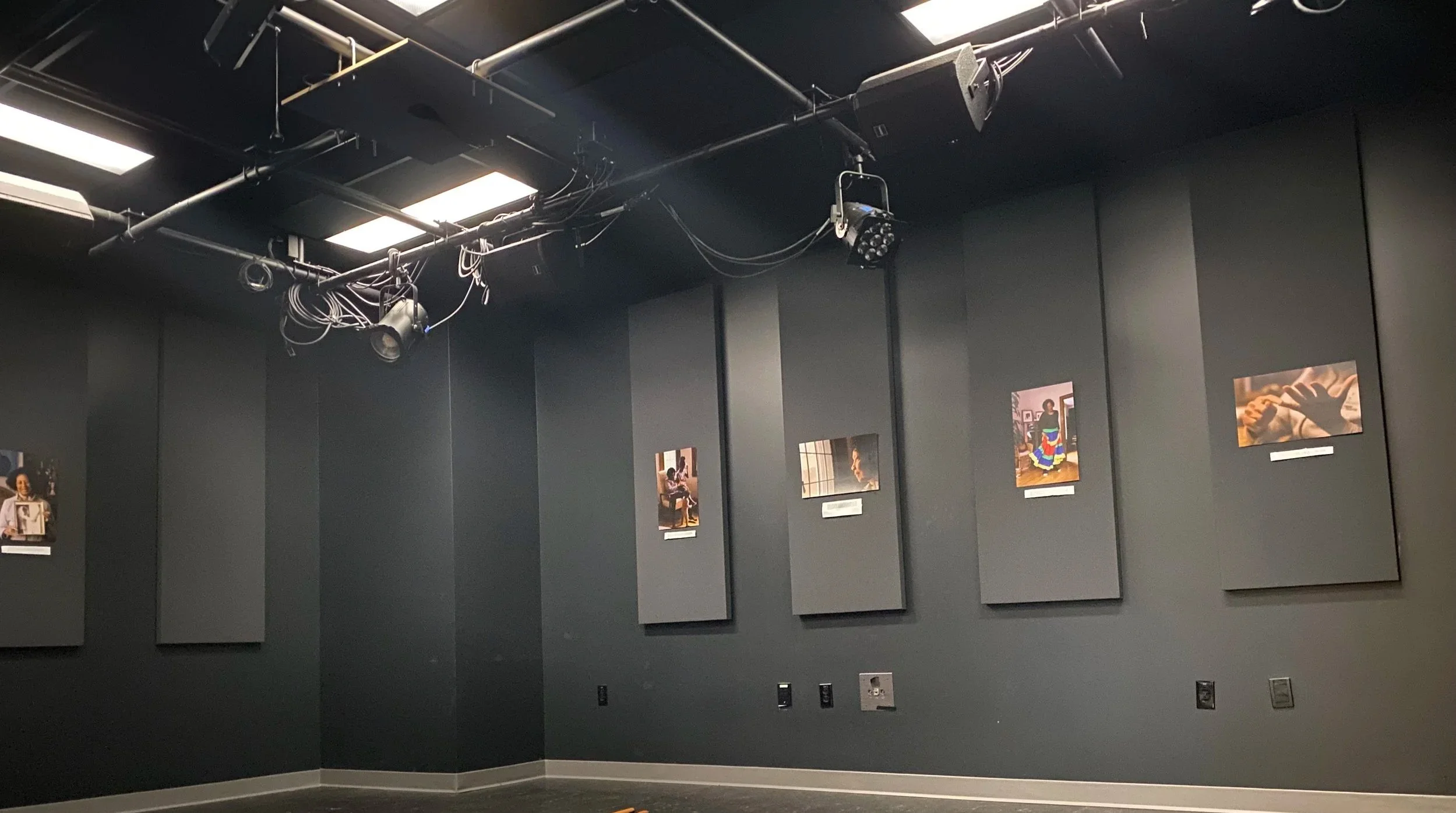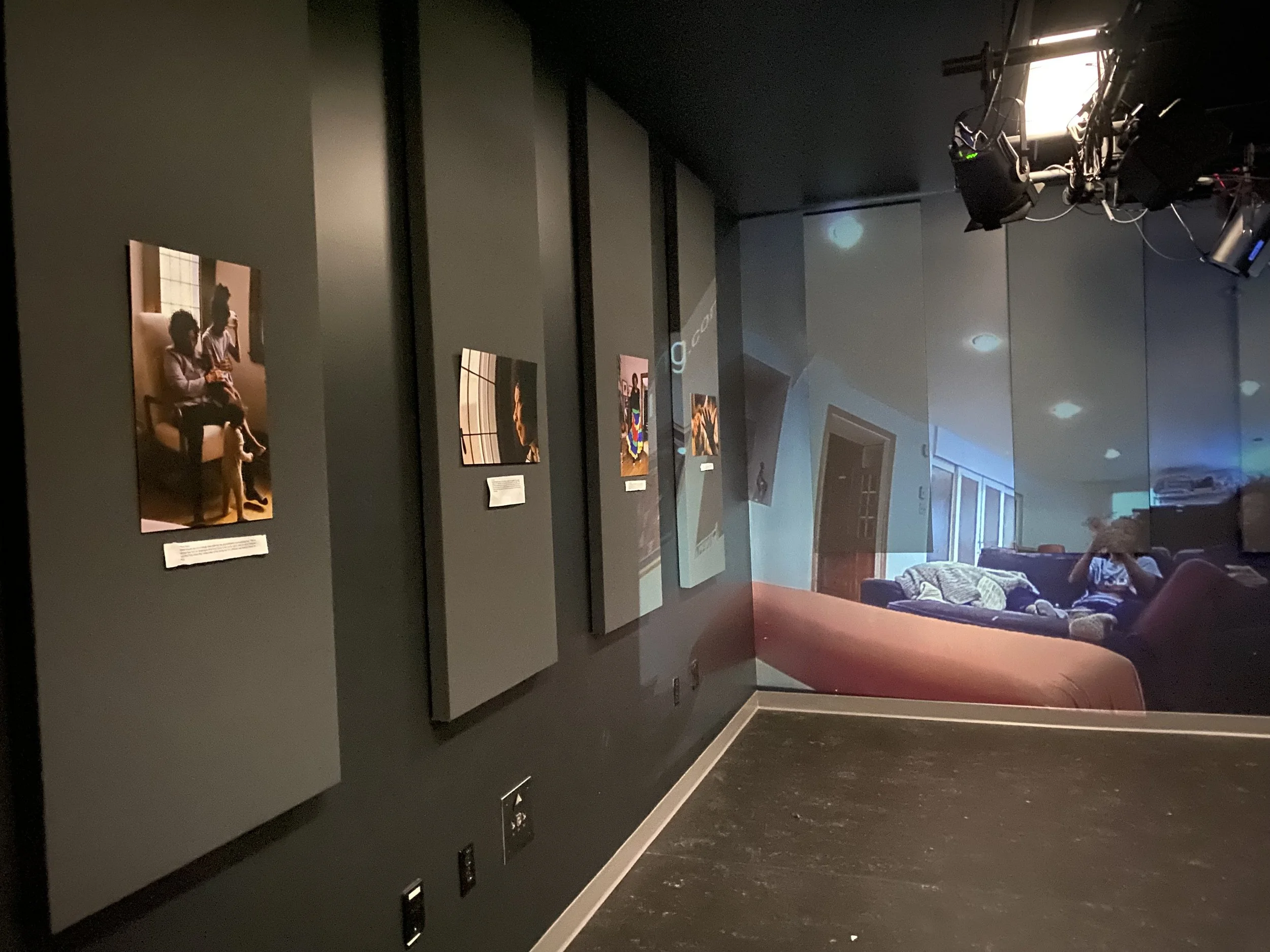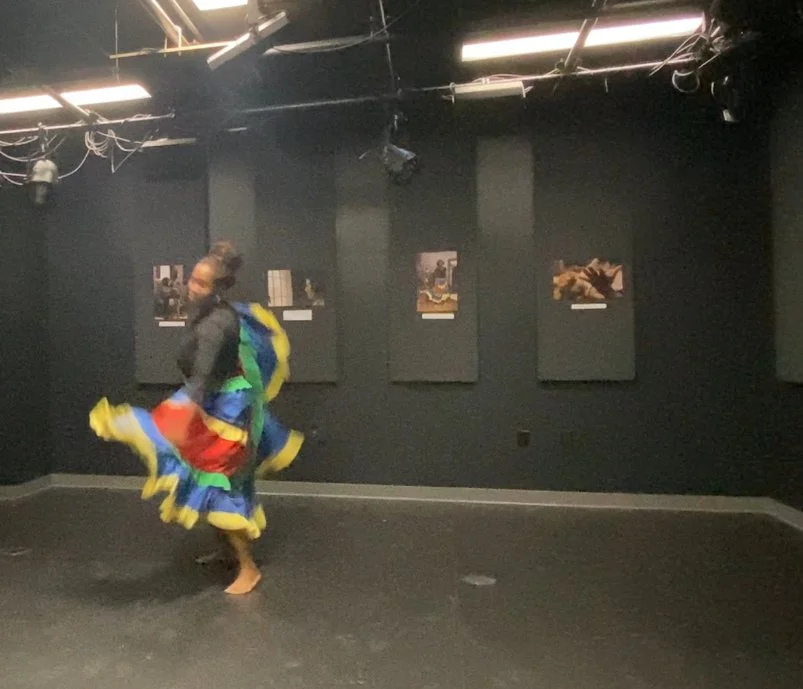WHere care meets creation
________________________________________________
Creative Composition and outline for future Art Installation | Exhibition
by Annick Maugile Flavien
For my studio comprehensive exam with Professor Deanna Bowen, I presented a multimedia creative composition entitled ‘Where Care Meets Creation’ that explores themes around Black Aging and Caregiving in Canada through autoethnographic research-creation exploration of our family’s experience of caregiving for my mother. My mother, Bernadette Maugile, is a Black Haitian woman who immigrated to Canada in 1962 when she was 20 years old and has participated and contributed greatly to Montreal’s society despite its racial limitations yet now further struggles to navigate this space and place as a Black elder and as a person with Alzheimer’s disease.
This webpage documents the creative pieces within this composition and outlines the layout I envision for a future art installation and exhibition of this work as it continues to grow.
* The presentation of the composition was set up in the Black Box at the Acts of Listening Lab at Concordia University, their generosity in sharing a space and technical resources to rehearse and explore presentation possibilities is much appreciated.
segment 1:
her black aging mind
My entry point into my field of research was the Black aging mind because as the daughter of two heavyweight Black intellectuals and social activists, who was raised through Black thought and the radicalism of valuing Black lives, I have seen first-hand the toll that this work and plain simply Black existence in an Anti-Black world takes on our aging minds. I have seen and learned how Anti-Black social structures erase Black experiences and occupy Black bodies and minds, which though viscerally enraging, has brought me to slow down enough to witness and appreciate the aging minds of Black elders. These elders, despite all odds, have managed to age into their senior years and embody an archive of presence and influence in this world, as well as an ongoing record of the impact and consequences the world has on Black life and aging.
When I began the creative observation of caring for the Black aging mind, I imagined Black elders or in this case my mother to be the main subject of the story. For weeks I carried a camera around and took countless pictures of my mother as we both got used to the presence of a camera between us. Going into the process without a clear sense of what I was looking for, allowed for a theme of memory snapshoots to emerge as I would often end up with photographs of similar movements, positions around our home, or conversation topics. This throughline allowed me to pick out a series of photographs that capture the subjects that my mother tends to fixate on. Because of her disease, her mind tends to roam without clear direction, and I can see that in moments where the roaming begins to feel overwhelming, she returns to these memory snapshots to ground her mind. The act of counting her siblings, revisiting the pictures in our home situates her in relation, or reciting her grandchildren’s full names situates her in relation, which once confirmed calms her mind and allows her to engage with the present again.
Still FRAMES OF Gran’s MIND
“Who’s this beautiful lady”
Bernadette Maugile notices a photo by the window sill of a beautiful woman in a wedding dress. It sparks her interest and she picks it up.
“That’s you mom”
Bernadette Maugile notices a photo by the window sill of a beautiful woman in a wedding dress. It sparks her interest and she picks it up. When her daughter tells her that it’s a photo of her wedding day she is surprised.
“Well, I look good!”
Bernadette Maugile notices a photo by the window sill of a beautiful woman in a wedding dress. It sparks her interest and she picks it up. When her daughter tells her that it’s a photo of her wedding day she is surprised. She then recognizes herself, beams, and says “Well, I look good!”
“Out there”
Bernadette Maugile looks out the window and talks to her daughter. The outdoor represent a lot of unknowns and discomforts for her, especially in the winter. In this conversation she talked about how she wishes the could would go somewhere warm so she can see people walking by again. She worries because she hasn't seen the neighbours in a while and wonders if they may have moved away because they don’t want to live next to a Black family.
“Manman m te gen 5 pitit”
Bernadette Maugile counts down her siblings on her fingers. She is the youngest of 5 children and the last surviving sibling. She regularly counts her siblings on her fingers to remember who has passed and wonders who is left in her home village in Haiti.
“Poto Mitan”
Mme Maugile sits on a rocking chair with her two grandchildren surrounding her. This is where they tend to congregate whenever she’s in the living room, she is what Haitians call the Poto mitan (the centre pole) of the family and the children are always drawn to her. Despite her disease she remembers about her grandchildren than anyone else in the family. One of her favourite pastimes is to recite their full names with emphasis on the last name they share with her.
“Culture Keeper”
Mme Maugile dances a traditional Haitian dance and sings ‘Bel Congo’ in Haitian Creole for her granddaughter. This is one of the ways she keeps her granddaughter entertained while her daughter takes care of the home. There isn’t a day that she doesn’t sing for her grandchildren, she feels this is best way she can share her culture with them.
Gran in MoTION
Though the still frames of memory take up a big part of her mind, there’s a notable release and lively reset that occurs after she’s managed to respond to the fixated concern and situate herself in regards to these memories. This reset is so anchored in the present moment and full of movement that it creatively steered me away from photography towards more spontaneous video capturing that better showcases the joyful and playful nature of my mother’s day-to-day, which though she may not be able to remember the moments as she does with the still frame memories, the movement and expression are nonetheless true to her experience.
Prior to this creative work, I had not paid close attention to what my mother is able to remember, insists on remembering, and feels comfortable forgetting. This process taught me that despite her disease, her brain still makes very intentional decision on what information to hold on to and with an urgency that is beyond my empathetic comprehension.
Studio comps presentation set up at Acts of Listening Lab Concordia
To present this work, I imagine a gallery set up where as you enter the space you see the photography set up on the left and right walls with the video projected in large format on a wall facing the entrance. The video would play on loop allowing visitors to pause and watch the video at any point while they engage with the photography and captions.
section 2:
the caregiving monologues
heard but not seen
The second segment of the ‘Where Care Meets Creation’, came about from a realization that though this creative work was coming from my perspective (an unbalanced dynamic I address further along in the process), I felt deeply unseen in the care work, which is untrue to our family dynamic, dismissive of my workload, and an incomplete picture of what care relationality entails. In response to this discomfort, I began voice recording my internal monologues around caregiving that don’t have much place to exist in our home. My mother and children have minimal interest in the theorizing I extrapolate from our daily lives, and I appreciated having a space to vent some of the weight of caregiving in a restorative way that does not directly impact my family. In this space I could unpack some of my concerns around research work on my personal family experience feeling redundant, extractive, or self-indulgent while in the same recording talking myself out of the limiting mindset.
For the purpose of the studio comps presentation I only shared one of the voice note audio files but imagine this piece to be a continous loop of multiple hours of self-reflection that a visitor could listen in on at any point.
Potential set up for art installation
For the set up of this piece I imagined something similar to a confessional booth, where it is clear that this corner of the exhibition is for a visitor to engage with alone and that the content is intimate. From my experience, as a radio host and podcaster, the imagery of a recording booth resonates a bit more than a confessional booth but I do want to want to inspire the sense, without religious connotation, that this is a space where someone can unload thoughts and emotions around caregiving.
In an ideal set up, visitors could also record their own ‘confessional’ to share to the project or write a thought on a post-it and paste it to the wall of the booth for others to read.
section 3:
black principles of co-creative care
In this third segment of the ‘Where Care Meets Creation’, I broke away from the elder-caregiver duality to look at our family care system as a whole and consider what principles and environments of care best allow for us to relate with one another and function at our greatest capacities. This query continuously brought me back to the physical and cultural safety of our home, large open spaces in nature, and creative making. In these moments of hiking together, remembering old Haitian folk tales and songs, learning our collective history, exchanging in non-linear conversations, the caregiving hierarchy is irrelevant, and each member of our participates and co-creates without assigned roles of leadership. My 1 year old daughter stimulates my mother memories through incessant desire for more songs while my 8 year son shows her inclusive care by being unfazed by her changing mind with matter of fact statement like ‘it’s ok I can tell her again, grandma has a hard time remembering sometimes’, my mother schools us all in with her phenomenal mastery of the French language which puts us all to shame, and in these moments where I am listening, laughing, sharing my own anecdotes I feel most seen for who I am rather than what I do for the family. In our home, caregiving for me is not just about making sure that my mother’s physical needs are met nor is it a unidirectional relation between caregiver and elder but it is a complex care network involving all the members of our family as we foster a space and context where she gets to be herself for as long as possible, I get to have the mother I knew for as long as possible, and for my children to know have the grandmother we didn’t even know she had inside of her.
For this segment of the exhibition I imagining creating an immersive space that feels like our home and can be the space for live presentations of my work (such as dance interpretations) and workshops. This space would be shaped and decorated with my mother and children, as is our home, with items that anchor us to our sense of identity, place and belonging. Overhead I imagine an audio loop of co-creating with my mother and children - this may come out as songs, stories, games, etc. And again for an expression of the movement in our home, I imagine a projected video compilation of what our care system looks and feels like on a daily basis. The video component of this segment is a challenge though because I want to share this beautiful co-created intimacy without crossing my boundaries around limiting my children’s presence online and preserving the privacy of our home. As well I am considering ways to share authorship and perspective in this project so that this collaborative isn’t just told from my narration.
Maybe it is as simple as letting my children take the camcorder and seeing where this leads us in our continued co-shaping of a space that values our Black lives?
seGment 4:
Kirk? Krak! | a call & response approach to research-curation
There remains one last segment of the ‘Where Care Meets Creation’ entitled ‘Kirk? Krak!’, which I have not begun creating yet because it requires the work to be out in the world, where I plan to invoke the Haitian Kirk? Krak! Storytelling practice of call and response as a model of story sharing in the Black community that implies that by bringing your story forward you are inviting dialogue and addition as response.
In a small way weaving together, even just for a moment, these separate experiences of Black elder care work contributes to my effort in fostering space for story and practice sharing around Black elder care in Black Canadian communities towards a larger goal of a having our Black voices heard, respected, and consulted in the broader context of Black Aging and Caregiving in Canada.













